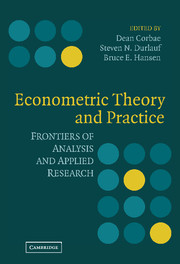Book contents
- Frontmatter
- Contents
- Preface: In Praise of a Remarkable Teacher
- Contributors
- Introduction
- PART I HIGHER-ORDER ASYMPTOTICS
- PART II IV SPECIFICATION TESTS
- PART III NONSTATIONARITY
- PART IV LAD AND QUANTILE REGRESSION
- PART V NONSTATIONARY PANELS
- 12 Combination Unit Root Tests for Cross-Sectionally Correlated Panels
- 13 Nonlinear IV Panel Unit Root Tests
- Index
13 - Nonlinear IV Panel Unit Root Tests
Published online by Cambridge University Press: 05 June 2012
- Frontmatter
- Contents
- Preface: In Praise of a Remarkable Teacher
- Contributors
- Introduction
- PART I HIGHER-ORDER ASYMPTOTICS
- PART II IV SPECIFICATION TESTS
- PART III NONSTATIONARITY
- PART IV LAD AND QUANTILE REGRESSION
- PART V NONSTATIONARY PANELS
- 12 Combination Unit Root Tests for Cross-Sectionally Correlated Panels
- 13 Nonlinear IV Panel Unit Root Tests
- Index
Summary
INTRODUCTION
Nonstationary panels have recently drawn much attention in theoretical and empirical research. This is largely due to the availability of panel data sets covering relatively long time periods and the growing use of cross-country and cross-regional data over time to investigate many important economic interrelationships – especially those involving convergence and divergence of economic variables. Various statistics for testing unit roots in panel models have been proposed and frequently used for testing growth theories and purchasing-power-parity hypotheses. Panel models are also used to study the long-run relationships between migration flows and income and unemployment differentials across regions and among macroeconomic and international financial series, including exchange rates and spot and future interest rates. Panel-data-based tests also appeared attractive to many empirical researchers because they offer alternatives to the tests based only on individual time series observations that are known to have low discriminatory power. The earlier contributors in theoretical research on the subject include Levin, Lin, and Chu (2002); Quah (1994); Im, Pesaran, and Shin (2003); and Maddala and Wu (1999). Phillips and Moon (2000) and Baltagi and Kao (2000) provide surveys on the recent developments in testing for unit roots in panels.
In general, panels are intrinsically heterogeneous and dependent across cross-sections, and these very properties contribute to the inferential difficulties in testing for unit roots. The cross-sectional dependency, in particular, is very hard to deal with in nonstationary panels.
- Type
- Chapter
- Information
- Econometric Theory and PracticeFrontiers of Analysis and Applied Research, pp. 334 - 358Publisher: Cambridge University PressPrint publication year: 2006



